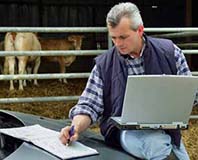Read the latest information on
Foot-and-mouth disease
 With on-farm biosecurity in the spotlight over the past few months, much has been made of what is ‘required’ in order for a producer to meet their biosecurity obligations. While many producers still have questions, the take-home message is simple: you have to make yourbiosecurity plan work for you.
With on-farm biosecurity in the spotlight over the past few months, much has been made of what is ‘required’ in order for a producer to meet their biosecurity obligations. While many producers still have questions, the take-home message is simple: you have to make yourbiosecurity plan work for you.
The important point to remember is that your biosecurity plan is a risk assessment. Completing a risk assessment isn’t about completely removing every risk, it’s about trying to minimise the harm that any risks could cause, without impacting on normal production and procedures.
In an ideal world, farms would be able to complete every action in the farm biosecurity checklists that are available to use. In reality, some actions are not always applicable to a property, others are not always practical and – while all of them are great recommendations – no single action is the difference between a successful or unsuccessful biosecurity plan.
Many recommended strategies – such as cleaning and disinfecting vehicles, controlling feral animals, installing entry gate signs or keeping a visitor log – are highly effective methods of ensuring threats can be prevented or contained.
However, every recommended action should be considered alongside the risks posed to the individual property. Producers should work together with their neighbours, consultants and even state department staff to determine which threats pose a high risk to their individual property and implement actions to counter those threats.
No program which calls for an on-farm biosecurity plan requires every action to be completed except the one required by law – the prohibition on feeding Restricted Animal Material to ruminant species.
The only requirement is that producers implement a plan which is applicable to their property, taking into account their unique risk factors.
Know your property, know your region, know your risks. Implement your biosecurity plan.
Producers looking to begin their biosecurity plan can download the Farm Biosecurity Action Planner, both of which can assist them in identifying risks and creating a checklist of recommended actions.
With thanks to Rachael O’Brien, Livestock Biosecurity Network Extension Manager for her help in developing this article.